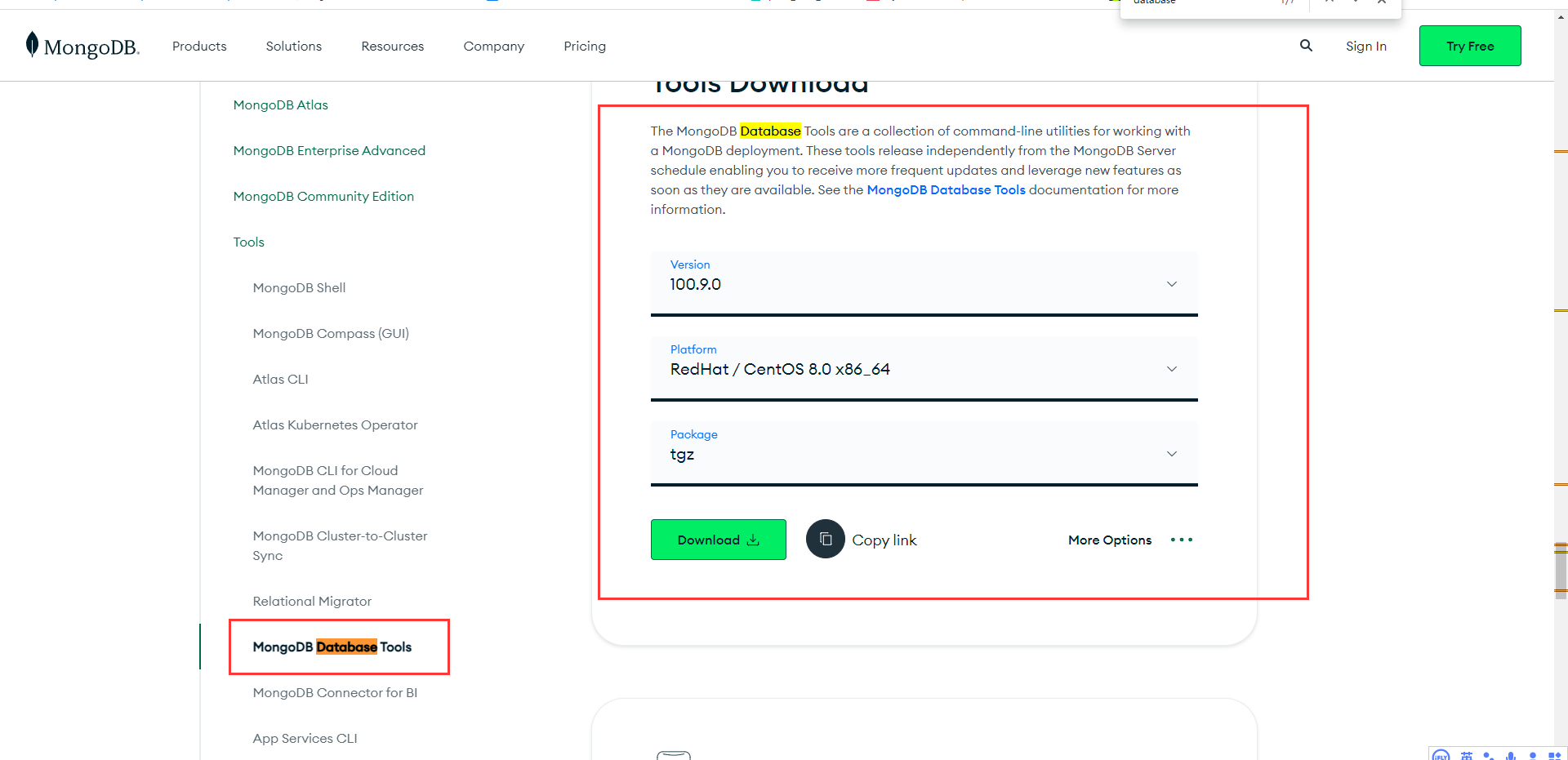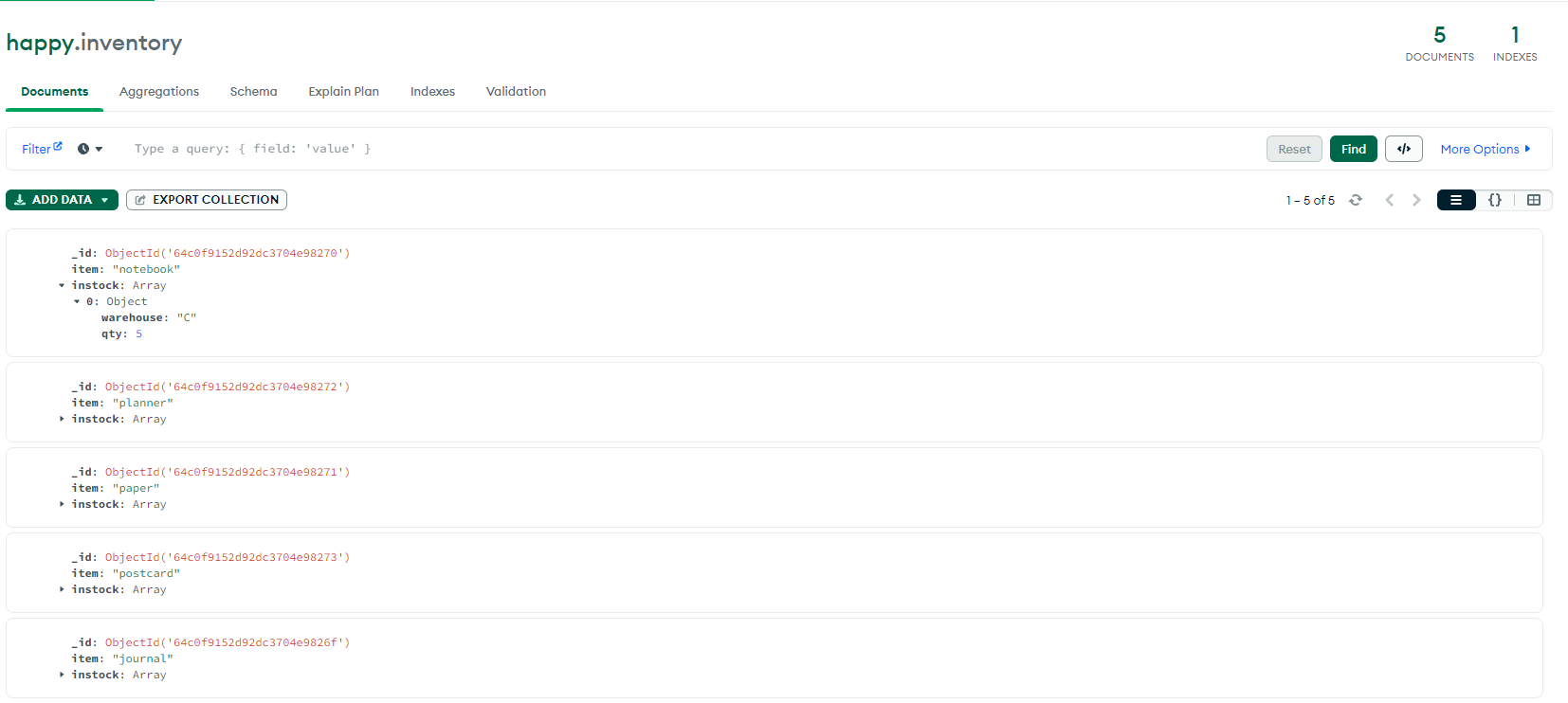备份与恢复
工具下载链接
https://www.mongodb.com/try/download/database-tools
本地链接
(Winodws版本):
mongodb-database-tools-windows-x86_64-100.9.0.zip
(Centos8版本):
1.MongoImport和MongoExport的使用
1.1MongoExport 导入 json csv文件
Mongodb中的mongoexport工具可以把一个collection导出成JSON格式或CSV格式的文件。可以通过参数指定导出的数据项,也可以根据指定的条件导出数据。mongoexport具体用法如下所示
[root@localhost mongodb]# ./bin/mongoexport --help
Export MongoDB data to CSV, TSV or JSON files.
options:
--help produce help message
-v [ --verbose ] be more verbose (include multiple times for more
verbosity e.g. -vvvvv)
--version print the program's version and exit
-h [ --host ] arg mongo host to connect to ( <set name>/s1,s2 for
sets)
--port arg server port. Can also use --host hostname:port
--ipv6 enable IPv6 support (disabled by default)
-u [ --username ] arg username
-p [ --password ] arg password
--dbpath arg directly access mongod database files in the given
path, instead of connecting to a mongod server -
needs to lock the data directory, so cannot be used
if a mongod is currently accessing the same path
--directoryperdb if dbpath specified, each db is in a separate
directory
--journal enable journaling
-d [ --db ] arg database to use
-c [ --collection ] arg collection to use (some commands)
-f [ --fields ] arg comma separated list of field names e.g. -f
name,age
--fieldFile arg file with fields names - 1 per line
-q [ --query ] arg query filter, as a JSON string
-type csv export to csv instead of json
-o [ --out ] arg output file; if not specified, stdout is used
--jsonArray output to a json array rather than one object per
line
-k [ --slaveOk ] arg (=1) use secondaries for export if available, default
true
参数说明:
-h:指明数据库宿主机的IP
-u:指明数据库的用户名
-p:指明数据库的密码
-d:指明数据库的名字
-c:指明collection的名字
-f:指明要导出那些列
-o:指明到要导出的文件名
-q:指明导出数据的过滤条件
例如导出json格式:
mongoexport.exe -h 192.168.14.215:27017 --authenticationDatabase admin -u happy -p=xxx -d happy -c inventory -o inventory.dat

例如导出csv格式(csv必须指定fields):
./bin/mongoexport -h 127.0.0.1:27017 --authenticationDatabase admin -u admin -p=xxx -d test -c students -type csv -f classid,name,age -o students_csv.dat
1.2MongoImport 导入 json csv文件
[root@localhost mongodb]# ./bin/mongoimport --help
options:
--help produce help message
-v [ --verbose ] be more verbose (include multiple times for more
verbosity e.g. -vvvvv)
--version print the program's version and exit
-h [ --host ] arg mongo host to connect to ( <set name>/s1,s2 for sets)
--port arg server port. Can also use --host hostname:port
--ipv6 enable IPv6 support (disabled by default)
-u [ --username ] arg username
-p [ --password ] arg password
--dbpath arg directly access mongod database files in the given
path, instead of connecting to a mongod server -
needs to lock the data directory, so cannot be used
if a mongod is currently accessing the same path
--directoryperdb if dbpath specified, each db is in a separate
directory
--journal enable journaling
-d [ --db ] arg database to use
-c [ --collection ] arg collection to use (some commands)
-f [ --fields ] arg comma separated list of field names e.g. -f name,age
--fieldFile arg file with fields names - 1 per line
--ignoreBlanks if given, empty fields in csv and tsv will be ignored
--type arg type of file to import. default: json (json,csv,tsv)
--file arg file to import from; if not specified stdin is used
--drop drop collection first
--headerline CSV,TSV only - use first line as headers
--upsert insert or update objects that already exist
--upsertFields arg comma-separated fields for the query part of the
upsert. You should make sure this is indexed
--stopOnError stop importing at first error rather than continuing
--jsonArray load a json array, not one item per line. Currently
limited to 4MB.
参数说明:
-h:指明数据库宿主机的IP
-u:指明数据库的用户名
-p:指明数据库的密码
-d:指明数据库的名字
-c:指明collection的名字
-f:指明要导入那些列
例如导入json格式:
>mongoimport.exe -h 192.168.14.215:27017 --authenticationDatabase admin -u happy -p=xxxx -d happy -c inventory --file inventory.dat导入前
导入后
例如导入csv格式:
./bin/mongoimport -h 127.0.0.1:27017 --authenticationDatabase admin -u admin -p=xxxx -d test -c students --type csv --headerline --file students_csv2.MongoDump和MongoRestore的使用
2.1MongoDump
general options:
/help print usage
/version print the tool version and exit
/config: path to a configuration file
verbosity options:
/v, /verbose:<level> more detailed log output (include multiple times for more verbosity, e.g. -vvvvv, or specify a numeric value, e.g. --verbose=N)
/quiet hide all log output
connection options:
/h, /host:<hostname> mongodb host to connect to (setname/host1,host2 for replica sets)
/port:<port> server port (can also use --host hostname:port)
ssl options:
/ssl connect to a mongod or mongos that has ssl enabled
/sslCAFile:<filename> the .pem file containing the root certificate chain from the certificate authority
/sslPEMKeyFile:<filename> the .pem file containing the certificate and key
/sslPEMKeyPassword:<password> the password to decrypt the sslPEMKeyFile, if necessary
/sslCRLFile:<filename> the .pem file containing the certificate revocation list
/sslFIPSMode use FIPS mode of the installed openssl library
/tlsInsecure bypass the validation for server's certificate chain and host name
authentication options:
/u, /username:<username> username for authentication
/p, /password:<password> password for authentication
/authenticationDatabase:<database-name> database that holds the user's credentials
/authenticationMechanism:<mechanism> authentication mechanism to use
/awsSessionToken:<aws-session-token> session token to authenticate via AWS IAM
kerberos options:
/gssapiServiceName:<service-name> service name to use when authenticating using GSSAPI/Kerberos (default: mongodb)
/gssapiHostName:<host-name> hostname to use when authenticating using GSSAPI/Kerberos (default: <remote server's address>)
namespace options:
/d, /db:<database-name> database to use
/c, /collection:<collection-name> collection to use
uri options:
/uri:mongodb-uri mongodb uri connection string
query options:
/q, /query: query filter, as a v2 Extended JSON string, e.g., '{"x":{"$gt":1}}'
/queryFile: path to a file containing a query filter (v2 Extended JSON)
/readPreference:<string>|<json> specify either a preference mode (e.g. 'nearest') or a preference json object (e.g. '{mode: "nearest", tagSets: [{a: "b"}], maxStalenessSeconds: 123}')
/forceTableScan force a table scan (do not use $snapshot or hint _id). Deprecated since this is default behavior on WiredTiger
output options:
/o, /out:<directory-path> output directory, or '-' for stdout (default: 'dump')
/gzip compress archive or collection output with Gzip
/oplog use oplog for taking a point-in-time snapshot
/archive:<file-path> dump as an archive to the specified path. If flag is specified without a value, archive is written to stdout
/dumpDbUsersAndRoles dump user and role definitions for the specified database
/excludeCollection:<collection-name> collection to exclude from the dump (may be specified multiple times to exclude additional collections)
/excludeCollectionsWithPrefix:<collection-prefix> exclude all collections from the dump that have the given prefix (may be specified multiple times to exclude additional prefixes)
/j, /numParallelCollections: number of collections to dump in parallel
/viewsAsCollections dump views as normal collections with their produced data, omitting standard collections
参数说明:
-h:指明数据库宿主机的IP
-u:指明数据库的用户名
-p:指明数据库的密码
-d:指明数据库的名字
-c:指明collection的名字
-o:指明到要导出路径
-q:指明导出数据的过滤条件
-o path (不归档的路径,二选1)
--gzip 压缩
--archive path(归档的路径+文件,二选1 )导出gzip格式的压缩文件:
mongodump.exe --authenticationDatabase admin -h 192.168.14.215:27017 -u happy -p=xxx -d happy -c products --archive=products.archive --gzip
2.1MongoRestore
general options:
/help print usage
/version print the tool version and exit
/config: path to a configuration file
verbosity options:
/v, /verbose:<level> more detailed log output (include multiple times for more verbosity, e.g. -vvvvv, or specify a numeric value, e.g. --verbose=N)
/quiet hide all log output
connection options:
/h, /host:<hostname> mongodb host to connect to (setname/host1,host2 for replica sets)
/port:<port> server port (can also use --host hostname:port)
ssl options:
/ssl connect to a mongod or mongos that has ssl enabled
/sslCAFile:<filename> the .pem file containing the root certificate chain from the certificate authority
/sslPEMKeyFile:<filename> the .pem file containing the certificate and key
/sslPEMKeyPassword:<password> the password to decrypt the sslPEMKeyFile, if necessary
/sslCRLFile:<filename> the .pem file containing the certificate revocation list
/sslFIPSMode use FIPS mode of the installed openssl library
/tlsInsecure bypass the validation for server's certificate chain and host name
authentication options:
/u, /username:<username> username for authentication
/p, /password:<password> password for authentication
/authenticationDatabase:<database-name> database that holds the user's credentials
/authenticationMechanism:<mechanism> authentication mechanism to use
/awsSessionToken:<aws-session-token> session token to authenticate via AWS IAM
kerberos options:
/gssapiServiceName:<service-name> service name to use when authenticating using GSSAPI/Kerberos (default: mongodb)
/gssapiHostName:<host-name> hostname to use when authenticating using GSSAPI/Kerberos (default: <remote server's address>)
namespace options:
/d, /db:<database-name> database to use
/c, /collection:<collection-name> collection to use
uri options:
/uri:mongodb-uri mongodb uri connection string
namespace options:
/excludeCollection:<collection-name> DEPRECATED; collection to skip over during restore (may be specified multiple times to exclude additional collections)
/excludeCollectionsWithPrefix:<collection-prefix> DEPRECATED; collections to skip over during restore that have the given prefix (may be specified multiple times to exclude additional prefixes)
/nsExclude:<namespace-pattern> exclude matching namespaces
/nsInclude:<namespace-pattern> include matching namespaces
/nsFrom:<namespace-pattern> rename matching namespaces, must have matching nsTo
/nsTo:<namespace-pattern> rename matched namespaces, must have matching nsFrom
input options:
/objcheck validate all objects before inserting
/oplogReplay replay oplog for point-in-time restore
/oplogLimit:<seconds>[:ordinal] only include oplog entries before the provided Timestamp
/oplogFile:<filename> oplog file to use for replay of oplog
/archive:<filename> restore dump from the specified archive file. If flag is specified without a value, archive is read from stdin
/restoreDbUsersAndRoles restore user and role definitions for the given database
/dir:<directory-name> input directory, use '-' for stdin
/gzip decompress gzipped input
restore options:
/drop drop each collection before import
/dryRun view summary without importing anything. recommended with verbosity
/writeConcern:<write-concern> write concern options e.g. --writeConcern majority, --writeConcern '{w: 3, wtimeout: 500, fsync: true, j: true}'
/noIndexRestore don't restore indexes
/convertLegacyIndexes Removes invalid index options and rewrites legacy option values (e.g. true becomes 1).
/noOptionsRestore don't restore collection options
/keepIndexVersion don't update index version
/maintainInsertionOrder restore the documents in the order of their appearance in the input source. By default the insertions will be performed in an arbitrary order. Setting this flag also enables
the behavior of --stopOnError and restricts NumInsertionWorkersPerCollection to 1.
/j, /numParallelCollections: number of collections to restore in parallel
/numInsertionWorkersPerCollection: number of insert operations to run concurrently per collection
/stopOnError halt after encountering any error during insertion. By default, mongorestore will attempt to continue through document validation and DuplicateKey errors, but with this option
enabled, the tool will stop instead. A small number of documents may be inserted after encountering an error even with this option enabled; use --maintainInsertionOrder to halt
immediately after an error
/bypassDocumentValidation bypass document validation
/preserveUUID preserve original collection UUIDs (off by default, requires drop)
/fixDottedHashIndex when enabled, all the hashed indexes on dotted fields will be created as single field ascending indexes on the destination
参数说明:
-h:指明数据库宿主机的IP
-u:指明数据库的用户名
-p:指明数据库的密码
-d:指明数据库的名字
-c:指明collection的名字
-dir path+*bson.gz (选择不归档的文件路径,2选1,之前导出是单个collection要加上*bson.gz ,多个不需要)
--gzip 压缩
--archive (选择归档的路径+文件,2选1) 导入命令:
mongorestore.exe --authenticationDatabase admin -h 192.168.14.215:27017 -u happy -p=xxx -d happy -c products --archive=products.archive --gzip
导入前:
导入后:
新建新集合
var result = db.csmdR.find({"查询条件"})
while(result.hasNext()) db.新建表名.insert(result.next())